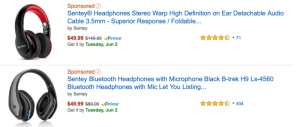
If there’s one thing we can say about getting ranked in search engines today, it’s that keyword-stuffing, article-spinning, low-quality links and other black-hat tactics just don’t work anymore.
SEO is a process, and like any process, it takes time. From content creation to optimizing load times, you won’t necessarily see the ROI on the work you put in today until much later.
To further complicate matters, Google doesn’t always rank your posts and pages for the keywords you’re trying to rank for. This is a game of patience if there ever was one.
However, there are best practices to improve search engine rankings for keywords you’ve handpicked. Here are seven of our best recommendations.
1. Check Your Titles
You’ve heard before that the post or page title plays a key part in driving traffic to your blog. While this is true, if your title does not contain the keywords you’re looking to rank for, it won’t have a shot in Google SERPs (search engine results pages).
This is blog post optimization 101, but to take things a little further, it’s worth exploring long-tail keywords (using a tool like Google AdWords: Keyword Planner) and incorporating them into your post title. Also, remember to make your post title specific (for example, “The Definitive Guide to SEO for Marketing Bloggers”, as opposed to just “Guide to SEO”).
There’s more that could be said about creating compelling titles. Have a look at “Do You Have to Optimize Your Blog Title For Search?” for additional tips.
2. Link Internally
If you’ve been creating content for any length of time, there’s a good chance you have an archive full of great content your visitors don’t immediately see when they come to your website. This alone is a good reason to link up related posts or content that connects to the subject matter at hand, and offers additional detail. This can also boost the amount of time your visitors spend on your site.
But there are other SEO benefits to internal linking, too. You can pass search engine “juice” to posts of a similar topic, thereby creating your own backlinks. Just don’t link to anything unrelated, since Google will not reward you for it.
3. Include Keywords In Your Content
Remember to add keywords in the content of your posts and pages, but in a natural way. Again, keyword-stuffing isn’t going to get you anywhere, and it might even harm your rankings.
But one thing you can do is add related keywords. For example, if you search for “healthcare” in Google, you’ll notice there are related searches toward the bottom of the page, such as “types of health services” or “health care tips.” If you also include these long-tail keywords in your content naturally, it could boost your SEO.

Google can sometimes offer valuable clues as to the kinds of related and long-tail keywords to add to your images or content.
4. Build Links
Building links for your chosen keywords and terms can help your content rank better. You can go about this many ways, including:
- Creating guest posts. Posting on other relevant industry blogs and including links back to your site can help you rank better for your terms. Check with your chosen blog’s owner to see whether they’re willing to include links to your site in your post.
- Conducting interviews. You can interview influential industry people and feature them on your blog or on your podcast. Most of the time, they’ll be more than happy to link to your site from theirs and share the interview with their audiences.
- Designing infographics. Eye-catching and engaging infographics tend to get a lot of shares and links. Include an embed field in your post to make them even more shareable.
5. Include Images In Your Posts
Images boost engagement, and therefore dwell time on your website. And as we’ve already noted, low bounce rates and high dwell time are good for SEO. Per HubSpot, articles with images get 94 percent more total views than those without.
So, by the same logic, images increase traffic, and if the traffic is high-quality, it will improve your rankings. In the same breath, HubSpot suggests using one image for every 350 words, as some of the highest-ranking blogs on the internet do.
Don’t forget to optimize the alt text for all your images, as well. Including related keywords can help your SEO, though the effect might not be substantive. To the extent that you can, decrease load times for images using plugins or image optimization tools.
6. Ensure Mobile-Friendliness
According to HubSpot, more Google searches take place on mobile devices than on computers in 10 countries, including the United States and Japan.
A lot of searches begin on tablets and smartphones. If your site isn’t mobile-friendly, not only are you making it difficult for your visitors to read your content, there’s a good chance you aren’t even ranking in mobile searches.
You’ve likely heard it before, but it’s worth reiterating: Use responsive design, and make it easy for mobile visitors to find what they’re looking for. This means optimizing and simplifying your navigation, as well.
Bonus tip: Google offers a free tool to check if a URL is mobile-friendly and offers recommendations if not.
7. Share Your Content and Get It Shared
Social signals are somewhat of a contentious issue, but posts with more social shares do tend to get better rankings. Shares lead to more traffic, and if your bounce rate is low, you will see an improvement in your rankings, too.
So, don’t forget to distribute your content on all the major sites like Facebook, Twitter, LinkedIn, Pinterest and other applicable channels, and make it easy for your visitors to share it on their favorite networks, too.
Increase the Visibility of Your Content In Search
Keep a close watch on your analytics—this will tell you what’s working, what isn’t and what requires further tweaking. Your best-laid plans and assumptions may prove incorrect, and a change in your strategy could become necessary.
It all begins with creating valuable content people want. If your content is well-targeted, and it meets the demands of your buyer persona, your rankings should gradually increase as more of your visitors read, share and link to your posts.
Digital & Social Articles on Business 2 Community(73)
Report Post






